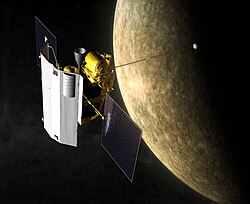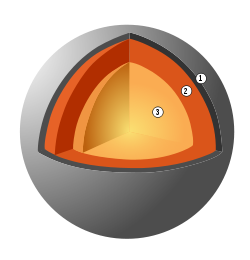PIA19247-Mercury-NPolarRegion-Messenger20150316
http://photojournal.jpl.nasa.gov/catalog/PIA19247
This view shows Mercury's north polar region, colored by the maximum biannual surface temperature, which ranges from >400 K (red) to 50 K (purple). As expected for the Solar System's innermost planet, areas of Mercury's surface that are sunlit reach high temperatures, and hence most of this image is colored red.
In contrast, some craters near Mercury's poles have regions that remain permanently in shadow, and in these regions even the maximum temperatures can be extremely low. Evidence from MESSENGER and Earth-based observations indicate that water ice deposits are present in these cold craters. The craters nearest Mercury' poles have surface temperatures less than 100 K (-173°C, -280°F), and water ice is stable on the surface, such as in Prokofiev. However, many craters near but somewhat farther from Mercury's poles have cold, permanently shadowed interiors, but the maximum temperature is too high for water ice to persist at the surface. In these craters, water ice is present but is buried beneath a thin, low-reflectance volatile layer likely consisting of organic-rich material, such as in Berlioz crater.
This image was presented at a press event at the Lunar and Planetary Science Conference. Visit the press event website to learn more!
Scale: Prokofiev, the largest crater near the top center of the image, has a diameter of 112 km (70 miles) Prokofiev Center Latitude: 85.77° Prokofiev Center Longitude: 62.92° E Map Projection: Orthographic
The MESSENGER spacecraft is the first ever to orbit the planet Mercury, and the spacecraft's seven scientific instruments and radio science investigation are unraveling the history and evolution of the Solar System's innermost planet. During the first two years of orbital operations, MESSENGER acquired over 150,000 images and extensive other data sets. MESSENGER is capable of continuing orbital operations until early 2015.Relevantní obrázky
Relevantní články
Merkur (planeta)Merkur je Slunci nejbližší a současně i nejmenší planetou sluneční soustavy, dosahuje pouze 140 % velikosti zemského Měsíce a je menší než Jupiterův měsíc Ganymed a Saturnův Titan. Merkur nemá žádný měsíc. Jeho oběžná dráha je ze všech planet nejblíže ke Slunci a jeden oběh trvá pouze 87,969 dne. Dráha Merkuru má největší výstřednost dráhy ze všech planet sluneční soustavy a sama planeta má nejmenší – téměř nulový – sklon rotační osy. Během dvou oběhů kolem Slunce dojde ke třem otočením kolem rotační osy. Perihelium jeho dráhy se stáčí ke Slunci o 43 vteřin za století; fenomén, který ve 20. století vysvětlil Albert Einstein obecnou teorií relativity. Při pohledu ze Země dosahuje Merkur jasnosti mezi -2,0 až 5,5m, takže je viditelný i pouhým okem, ale jelikož se nikdy nevzdaluje od Slunce dále než na 28,3°, je většinu roku těžko pozorovatelný. Nejlepší podmínky nastávají při ranním a večerním soumraku, kdy se slunce nachází pod horizontem. .. pokračovat ve čtení

















